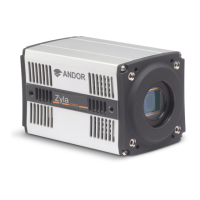version 2.0 rev 18 Feb 2021
77
APPENDIX C: DEW POINT GRAPH
To avoid issues with condensation, the coolant temperature must be set above the dewpoint- the temperature
at which condensation (dew) will form. In the relatively dry conditions of an air conditioned lab, or a cool dry
climate, use of a coolant temperature of 10°C should not cause any problems. As relative humidity or ambient
temperature increase however, the dewpoint temperature will also increase so that the minimum coolant
temperature that can be used will have to increase accordingly. This will therefore limit the maximum cooling
performance that can be achieved.
Therstsignsthatcondensationisformingwillbeonthecoolantconnectionsenteringandexitingthecamera.
Use of coolant at or below the dewpoint can result in permanent damage to the camera head due to formation
of condensation on internal components. It is therefore very important to ensure that coolant temperature is
above the dewpoint. Further guidelines are provided in Section 6.8. The relationship between Relative Humidity
and Dew Point at varying Ambient Temperature is shown above. There is also an inbuilt calculator in Solis, as
well as a range of dewpoint calculators on-line that you can enter ambient temperature and relative humidity
to calculate the dewpoint for your conditions.
20
30
40
50
60
70
80
90
100
0 5 10 15 20 25 30
Relative Humidity (%)
Dew Point (°C)
68%humidityat30°C
ambient temperature:
dewpointis~23°C
Ambient Temperature
20°C 22°C 24°C 26°C 28°C 30°C

